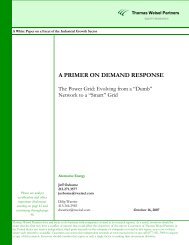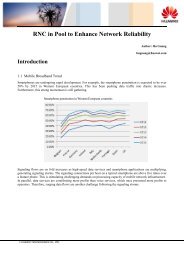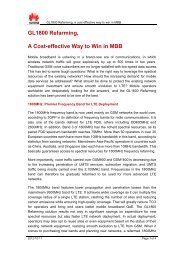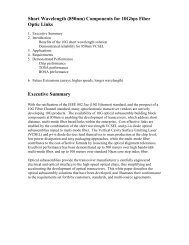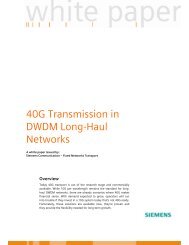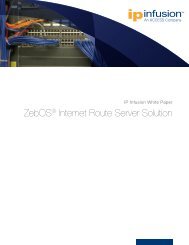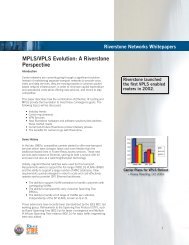Making High Bandwidth But Low Revenue Per Bit ... - Light Reading
Making High Bandwidth But Low Revenue Per Bit ... - Light Reading
Making High Bandwidth But Low Revenue Per Bit ... - Light Reading
Create successful ePaper yourself
Turn your PDF publications into a flip-book with our unique Google optimized e-Paper software.
<strong>Making</strong> <strong>High</strong> <strong>Bandwidth</strong> <strong>But</strong> <strong>Low</strong> <strong>Revenue</strong> <strong>Per</strong> <strong>Bit</strong><br />
Network Applications Profitable<br />
Abstract<br />
IMPLICITLY, ALL PREVAILING ‘NEW’ NETWORK TECHNOLOGY<br />
MARKETING, REGARDLESS OF THE ACRONYMS AND BUZZWORDS USED,<br />
AVOID ADDRESSING THE VERY FUNDAMENTAL REASON FOR LOWER<br />
THAN EXPECTED PROFITABILITY BUILT‐IN WITH ALL CURRENT PACKET‐<br />
SWITCHED (E.G. IP, MPLS OR ETHERNET PROTOCOL BASED) NETWORK<br />
SERVICES.<br />
TO DISPEL THE HYPE, OCS PROVIDES A BUZZWORD‐FREE LOOK AT WHY,<br />
AND OFFERS A VIEW ON HOW TO REACH THE REQUIRED NEW<br />
STANDARD OF EFFICIENCY.<br />
Page 1 of 7 © Optimum Communications Services, Inc. All rights reserved.
It is well known that packet<br />
oriented network protocols<br />
such as Internet Protocol (IP)<br />
cause highly time‐variable<br />
(bursty) traffic loads between<br />
the communicating IP nodes<br />
over the networks that<br />
deliver the IP packets.<br />
However, less attention has<br />
been paid to the fact that so<br />
far, bandwidth allocation at<br />
the physical networks<br />
between the IP nodes is<br />
statically provisioned, even<br />
though packet traffic loads<br />
are anything but static.<br />
As IP video, multimedia and<br />
transaction data etc. service<br />
bandwidth volumes keep<br />
exploding while the revenue<br />
per bit of network services<br />
continues to decrease, this<br />
mismatch between the<br />
prevailing packet traffic<br />
dynamics and the static<br />
partitioning of the delivery<br />
network is causing<br />
unsustainable levels of<br />
inefficiencies built‐in with all<br />
prevailing network<br />
technologies and services<br />
that rely on statically<br />
provisioned network physical<br />
layer capacity allocation.<br />
Thus the questions:<br />
Why is network physical<br />
layer bandwidth<br />
allocation still static in<br />
prevailing network<br />
implementations?<br />
And will this have to<br />
change in order to make<br />
a sustained business case<br />
for the emerging service<br />
mix dominated by high‐<br />
bandwidth multimedia<br />
etc. applications offering<br />
relatively low revenue,<br />
while demanding high<br />
Quality of Service (QoS)?<br />
Internet <strong>Bandwidth</strong> Allocation Is Still Statically Partitioned at the<br />
Network Physical Layer ‐ Why?<br />
To realize the level of structural inefficiency that static partitioning of<br />
network capacity causes, let’s recall how IP itself serves its application<br />
protocols:<br />
With today’s IP, the L3 packets are generated and sent between IP host<br />
nodes when and where demanded by the L4+ client applications, for<br />
reason of network usage efficiency ‐‐ it is obvious that a fixed IP<br />
connectivity model would be coarsely wasteful: in such a scenario each<br />
given IP node would send fixed‐length IP packets (filled with client<br />
application, or idle, bytes depending on the momentary demand) at fixed<br />
intervals to all other IP nodes with which the given node may at times<br />
have traffic to send, causing the IP server layer bandwidth (BW) to be<br />
most of the time either severely insufficient vs. application demands, or<br />
simply wasted as idle packets.<br />
90<br />
80<br />
Load /<br />
70<br />
reservation<br />
60<br />
as % of<br />
50<br />
application I/O<br />
40<br />
bandwidth /<br />
30<br />
network<br />
20<br />
capacity 10<br />
0<br />
1 2 3 4 5 6 7 8 9 10<br />
time/100ms<br />
Lost revenue<br />
opportunity due to<br />
static provisioning<br />
(most of the time)<br />
unnecessarily limiting<br />
the throughput<br />
Dynamic application traffic load<br />
Statically provisioned bandwidth<br />
for application<br />
Wasted cost as<br />
reserved but (most of<br />
the time) un‐<br />
utilized network<br />
capacity<br />
At network physical<br />
layers (L1/0),<br />
the conventional<br />
technologies (fiber/<br />
WDM/SDH/OTN<br />
etc.) are limited to<br />
similar architectural<br />
inefficiency when<br />
carrying packetized<br />
L2+ (MPLS or direct<br />
IP over PPP,<br />
Ethernet etc.)<br />
traffic, as would be<br />
the case with fixed IP transmission for carrying variable BW L4+<br />
applications. The industry has dealt with this structural inefficiency<br />
mainly by over‐provisioning the (fixed capacity allocation based) L1/0<br />
networks ‐‐ and even though such over‐provisioning is not necessarily<br />
apparent in the light of average traffic loads, there in reality is plenty of<br />
room for efficiency gain when looking at the networks at the level that<br />
they really operate, which is at packet by packet level (this is analogous<br />
with the scenario of fixed‐BW IP mesh).<br />
To appreciate the new levels of efficiency that adaptive L1 can bring to<br />
networking, it should be realized that the current practice of using non‐<br />
adaptive network physical layer is really just an artificial limitation caused<br />
by that the conventional L1/0 equipment cannot support adaptive BW<br />
physical layer channeling, and that therefore, if technically feasible, also<br />
L1 BW allocation should be adaptive to realtime L2+ packet traffic load<br />
variations, for the same reasons that L3 IP packet transmission is<br />
adaptive to the L4+ application demands.<br />
Thus, to assert that L1 connection capacity allocation may well remain<br />
fixed while carrying packetized L2+ traffic loads without any significant<br />
loss of efficiency is equal to saying that L3 IP BW connectivity should be<br />
fixed when carrying packet oriented L4+ applications:<br />
Page 2 of 7 © Optimum Communications Services, Inc. All rights reserved.
The use of fixed (or non‐adaptive) BW L1<br />
capacity allocation for exchanging packet based<br />
L2+ flows is similar in its (in)efficiency as it<br />
would be to have a constant BW, pre‐scheduled<br />
L3 packet transmission between a given IP node<br />
and each other IP destination/source that the<br />
given node may at times have any L4+ packets<br />
to exchange with: If the L3 send (receive)<br />
capacity of a given node would be e.g. 1Gbps,<br />
and it would have say 1,000 other IP end‐nodes<br />
that it communicates with at times, to work<br />
analogous to the prevailing L1/0 technologies, it<br />
should statically partition its 1Gbps of IP<br />
communications capacity to 1000 fixed BW IP<br />
tunnels (of 1kbps each in average) ‐‐ although<br />
the node at any given time will have active L4+<br />
communications sessions with only a few of its<br />
source/destination IP nodes and is receiving or<br />
transmitting a packet to/from only one of IP<br />
source/destination, and could thus do it at<br />
1Gbps. Static L3 capacity allocation in this<br />
scenario would thus reduce the effective inter‐<br />
node throughput by a rate of 1000:1 or such,<br />
achieving but 0.1% of the possible throughput.<br />
Though the above example may not be directly<br />
applicable for all inter‐node IP communications<br />
scenarios, it nevertheless serves to illustrate the<br />
fundamental reason why IP connectivity had to be<br />
made packet based, and the drastic loss of<br />
efficiency that a static partitioning of server layer<br />
resources creates for packet oriented (chatty,<br />
bursty) applications ‐‐ whether apparent or hidden<br />
‐‐ and in equal manner, whether in case of carrying<br />
L4+ traffic over L3 connectivity, or L2+ packets over<br />
L1/0 connections.<br />
Common examples of the prevailing static<br />
partitioning of physical network capacity allocation,<br />
even when carrying variable BW traffic between a<br />
group of packet‐switching end‐points such as IP<br />
nodes/routers include:<br />
Use of separate fibers (on same corridors);<br />
Use of separate WDM channels on same fiber,<br />
whether of not using a packet based or carrier<br />
signal such as Ethernet;<br />
Use of separate (non‐adaptive) TDM channels<br />
on same WDM wavelength or fiber strand,<br />
whether based on traditional TDM protocols<br />
such as SDH/SONET or emerging techniques<br />
such as OTN, including ODU flex and such.<br />
So why, after several years of increasingly packet<br />
based network application traffic, the network<br />
physical layer protocols are based on pre‐<br />
provisioned, (semi‐)fixed BW connections, instead of<br />
packet‐by‐packet adaptive connectivity?<br />
As a reaction, one could try to argue that adaptive L1<br />
is not needed when using L2 ‘soft‐circuits’ (e.g..<br />
MPLS‐TE LSPs, or PW, Ethernet equals) to allow L3<br />
source‐destination flows to more flexibly share L1/0<br />
connection capacities. However, such argument is<br />
illogical at least for the following reasons:<br />
Unlike on inter‐router L1/0 circuits, on L2<br />
packet‐switched paths the traffic encounters<br />
intermediate packet‐switching hops, each of<br />
which increases delay, jitter 1 2 and packet loss<br />
probability, as well as packet processing and<br />
related overhead (power, OAM) costs,<br />
degrading network cost‐efficiency and<br />
scalability.<br />
1<br />
The major reasons for jitter on L2 networks are not so<br />
much the variations in packet‐processing delays at<br />
intermediate nodes, but the fact that when transmitting<br />
packets between L3/2 nodes over non‐channelized L1/0<br />
connections, at most one packet may be transmitted at<br />
any given time, while all other packets, no matter how<br />
short and how high priority, directed over the same L1/0<br />
interface will have to wait until the present packet, no<br />
matter how long and how low priority, being sent has<br />
been transmitted in its entirety over the shared L1 port.<br />
For instance, a 64kB jumbo frame on 1Gbps interface<br />
blocks all other traffic, regardless of priority, for 0.5ms, per<br />
each such shared transmission interface between the<br />
source and destination nodes. This should be compared<br />
against typical business network SLA jitter specifications,<br />
e.g. max 2ms total, meaning that even just four such<br />
shared 1GbE switch interfaces between the customer<br />
nodes have the potential to reach the maximum jitter<br />
tolerance, leaving no budget for jitter caused by packet<br />
processing, switching and congestion buffering, the latter<br />
of which can be substantial. In practice, the consequence<br />
is that, unlike L1 switched networks, L2 switched networks<br />
can only have a limited, such as maximum of 3,<br />
aggregation/switching nodes between the customer<br />
interfaces, and that L2 switched networks will thus end up<br />
having to be expensively over provisioned (kept at low<br />
average utilization) for any delay and jitter sensitive traffic,<br />
incl. the higher revenue applications such as voice, video<br />
conferencing, IPTV, multimedia and business applications<br />
such as data replication and transaction processing.<br />
2<br />
Note that with L1 channelization, multiple packets can be<br />
sent in parallel over same L1 ports, and with adaptive L1<br />
channelization, the highest priority and highest load<br />
packet flows getting most bandwidth dynamically.<br />
Page 3 of 7 © Optimum Communications Services, Inc. All rights reserved.
Since most higher revenue applications require<br />
minimum throughput and maximum jitter and<br />
latency guarantees, L2 ‘soft circuits’ need<br />
physical BW reservations, which all other traffic<br />
must honor at all times whether or not these<br />
static BW reservations are being used. Thus L2<br />
‘virtualization’ of L1/0 resources amounts to<br />
nothing more elegant than fixed BW allocation,<br />
just done at packet‐layer rather than via L1<br />
TDM or L0 WDM (and thus requiring complex<br />
packet‐layer QoS policing at network nodes).<br />
L2 ‘soft circuits’, just like traditional non‐adaptive L1<br />
circuits, thus impose artificially low BW caps for the<br />
packet traffic flows, unavoidably reducing the<br />
available throughput to/from any given L3 node.<br />
Studied Source<br />
router 1<br />
Source<br />
2<br />
Inter‐router<br />
L2 packet traffic flows<br />
Studied Source<br />
router 3<br />
Source<br />
4<br />
Studied<br />
destination<br />
To take the discussion to a more concrete level of<br />
switching and transport network design, let’s<br />
consider a case of a routing node with an assumed<br />
10Gbps full duplex interface throughput (this could<br />
be any other bit rate just as well) over which the<br />
router exchanges traffic with eight other peer<br />
routers (and this again could be any other number<br />
typical for router adjacencies). While the 10Gbps<br />
router interface is L1‐unchannelized ‘fat pipe’, it is<br />
partitioned at packet‐layer to traffic engineered L2<br />
‘soft circuits’ (e.g. LSPs, called here “flows”), and for<br />
the sake of simplicity of illustration we assume there<br />
to be one such flow per each of the 8 peer routers<br />
(in each direction). Fig. 1 shows this network<br />
diagram studied.<br />
Studied Source<br />
router 5<br />
Packet switching/transport network<br />
Source<br />
6<br />
Studied Source<br />
router 7<br />
Shared<br />
10Gbps L1 port to<br />
the studied destination<br />
router<br />
Source<br />
8<br />
Fig. 1. A generic diagram for analyzing the packet transport network partitioning dilemma. Arrows represent the L2 flows<br />
that can be traffic engineered for committed bandwidth rates, to share the network capacity toward the studied destination.<br />
In Fig. 1, how should the inter‐router network BW be<br />
allocated 3 , assuming that the external application<br />
3 Though we here focus on BW allocation from multiple<br />
sources toward a chosen destination packet‐switch/router,<br />
the analysis that follows would be similar when studying<br />
generated traffic loads for the inter‐router network<br />
can be managed (e.g. via packet‐layer QoS policing)<br />
at most on 1 second intervals?<br />
the transmit direction BW allocation from a given packet‐<br />
switching source node toward a number of destinations.<br />
Page 4 of 7 © Optimum Communications Services, Inc. All rights reserved.
To study that question using a specific (but<br />
representative and practical scenario), let us further<br />
assume for the case of Fig. 1 that the 1s‐average BW<br />
quotas of the L2 traffic flows (#1 ‐ #8) from the<br />
Flow #7, 50%<br />
Flow #8, 5%<br />
source routers 1 through 8 respectively over the<br />
shared 10Gbps capacity to the studied destination<br />
are provisioned per Fig. 2.<br />
Flow #1, 5%<br />
Flow #2, 20%<br />
Flow #5<br />
, 5%<br />
Flow #6, 5%<br />
Flow #3, 5%<br />
Flow #4, 5%<br />
Fig. 2. Example partitioning of the L1 network capacity toward the studied destination router 10Gbps port among the L2+<br />
traffic flows from the eight source routers sharing that physical port.<br />
Thus, over time windows such as 1 second, it may be<br />
possible to control the applications feeding the inter‐<br />
router flows to not exceed their committed rates,<br />
such as 0.5Gbps for flow #3 from the source router 3<br />
to the destination of Fig. 1. However, the real traffic<br />
materializes as individual packets that are always<br />
transmitted at full physical port bit rates, which in<br />
the case of Fig. 1 where the routers are assumed to<br />
have 10Gbps ports to the packet transport cloud,<br />
means that each of the flows from source routers of<br />
Fig 1, at any given time instance, either would have a<br />
packet to transmit at the full link rate of 10Gbps or<br />
otherwise will idle at 0bps.<br />
Moreover, the collective packet traffic flows from<br />
the individual users and applications constituting the<br />
inter‐router flows are not directly controllable by the<br />
network, and therefore at finer time granularity, e.g.<br />
at 100ms windows, the optimal (revenue<br />
4 5 6<br />
maximizing) allocation of network bandwidth<br />
4 Note that it is technically possible to keep network<br />
physical BW allocation optimized per packet by packet<br />
load variations, without any significant offsetting cost<br />
factors, per specifications of US patent application<br />
12/363,667 and related patents 7,558,260 and 7,333,511;<br />
between the individual flows of Fig. 1, while<br />
averaging to their committed rates over time per Fig.<br />
2, may look like the example shown in Fig. 3.<br />
these techniques moreover are known to demonstrably<br />
work in test networks.<br />
5 A key reason why adaptive L1 channelization per above<br />
references is able to optimize network physical BW<br />
allocation according to packet byte traffic load variations<br />
of the flows, while honoring all minimum flow BW quotas<br />
(whenever actually needed by flow traffic loads), is the<br />
patented, destination node driven distributed hardware<br />
logic algorithms (per above patent references) that keep<br />
the network control plane in byte‐timeslot accurate sync<br />
with the dynamically channelized data plane.<br />
6 One of the reasons why conventional L3/2 traffic<br />
engineering methods cannot do this packet traffic load<br />
adaptive optimization is that, being software based and<br />
thus non‐synchronous with data plane, as well as not<br />
destination node driven, they at the source nodes lack the<br />
foresight of when and how much they could exceed their<br />
committed BW quota without blocking other flows. Thus,<br />
conventional L3/2 TE techniques have to rely on statically<br />
provisioned flow rate limiting, unnecessarily blocking flow<br />
bursts as well as keeping reserved capacity idling when the<br />
flow traffic did not materialize (illustrated in Fig. 4).<br />
Page 5 of 7 © Optimum Communications Services, Inc. All rights reserved.
Optimal allocation<br />
of network<br />
bandwidth based<br />
on the application<br />
bandwidth<br />
demands per flow<br />
%<br />
100<br />
80<br />
60<br />
40<br />
20<br />
0<br />
1 2 3 4 5 6 7 8 9 10<br />
Time / 100 ms<br />
Flow #1 (committed 5%)<br />
Flow #2 (committed 20%)<br />
Flow #3 (committed 5%)<br />
Flow #4 (committed 5%)<br />
Flow #5 (committed 5%)<br />
Flow #6 (committed 5%)<br />
Flow #7 (committed 50%)<br />
Flow #8 (committed 5%)<br />
Fig. 3. An example of what the optimal allocations of bandwidth for the flows of Fig:s 1 and 2 could be at timescales finer<br />
than what QoS policing can operate.<br />
To analyze the impact of the static partitioning of the<br />
inter‐router network BW allocation on the network<br />
on‐time throughput i.e. its revenue generation<br />
potential, let’s take a detail look at how the real per‐<br />
Blocked<br />
throughput<br />
(lost<br />
revenue)<br />
Load<br />
%<br />
50<br />
40<br />
30<br />
20<br />
10<br />
0<br />
1 2 3 4 5 6 7 8<br />
Flow #<br />
Loads between 600ms and 700ms<br />
flow application BW demands and their committed<br />
network BW allocations can compare over a slice of<br />
time such as 100ms, e.g. the 600ms to 700ms time<br />
window from Fig. 3, presented below in Fig. 4.<br />
Reserved but<br />
unused<br />
bandwidth<br />
(wasted cost)<br />
Application demand = optimal<br />
bandwidth allocation<br />
Committed share = real<br />
bandwidth allocation with<br />
conventional static physical<br />
network capacity partitioning<br />
Fig. 4. A representation of a continuously occurring mismatch between actual application demands for and average‐load<br />
based allocation of inter‐router BW in case of (semi‐)static partitioning of physical network BW: While static partitioning of<br />
L1 BW can be seemingly correct vs. average L2+ flow traffic distribution, at actual packet timescales, any static BW allocation<br />
will be completely off vs. actual packet by packet loads effectively all the time, directly eroding service provider profitability.<br />
Page 6 of 7 © Optimum Communications Services, Inc. All rights reserved.
The case of Fig. 4 shows that the prevailing static partitioning of physical<br />
network BW allocation severely reduces network profitability, both<br />
through i) unnecessarily limiting network revenue generating service<br />
volume via blocking traffic flows beyond their average committed quotas<br />
and ii) requiring multiple times more spending on the network capacity<br />
due to the under‐utilized flow BW reservations than what would be<br />
necessary (with packet‐by‐packet adaptive L1 BW allocation) for the<br />
achieved throughput. In practice, with adaptive L1 channelization, e.g.<br />
40Gbps of interface capacity can thus support more revenue generating<br />
service volume than a statically partitioned 100Gbps interface.<br />
To round up the discussion and to provide context for above illustrations:<br />
For clarity of illustration, there is always assumed to be enough<br />
application traffic, e.g. data back‐up etc. background transfers,<br />
available to utilize the studied network capacity. In reality, there<br />
could be more (oversubscription) or less (under‐utilization), but in<br />
any case a static partitioning of the transport network BW would<br />
reduce network profitability for the reasons i) and/or ii) above, just<br />
in different proportions, but with same end result.<br />
Applications are assumed to not tolerate delays (or jitter) more than<br />
100ms i.e. the network cannot just buffer a burst of traffic to be<br />
delivered over time on a lower BW path; such delayed traffic would<br />
be same as lost from the applications’ point of view.<br />
- The study above could be taken to ever finer time granularity,<br />
e.g. to microsecond level (e.g. a 1kB packet consumes roughly 1<br />
microseconds at 10Gbps) where software based QoS policing is<br />
not feasible in any manner, still producing similar insights.<br />
At any instant in time, there is always some allocation of physical<br />
network BW among the inter‐router flows that maximizes the total<br />
network utility, e.g. its revenue for the network service provider, and<br />
while the averaged BW allocation can over time windows such as 1<br />
second or longer be fairly static (from a 1 second window to the<br />
next), at the packet‐by‐packet granular time windows<br />
(microseconds) the revenue‐maximizing optimum BW allocation is<br />
highly dynamic, as it is based on the application demands for<br />
network BW, which always are highly time variable as they are made<br />
of intermittent full link rate packet transmissions alternating with<br />
idle periods (even when over longer time periods the flows can be<br />
policed to stay within their committed BW levels).<br />
Thus, in order to reach the next level of network efficiency necessary for<br />
a profitable business case for emerging high‐BW and high‐QoS, but<br />
relatively low revenue/bit, services, the packet‐load adaptive network<br />
allocation efficiencies have to be taken all the way to the network<br />
physical layer. Moreover, BW optimization at network physical layer<br />
eliminates the need for the complex packet‐layer stat‐muxing done in<br />
current networks to gain BW efficiencies, and which when (as typically is<br />
the case) done across different client applications causes major<br />
everything‐affects‐everything type QoS and security problems. The<br />
transition from prevailing (semi‐)static to traffic load adaptive physical<br />
layer BW allocation thus appears to be one of those efficiency gain<br />
measures that does not increase complexity elsewhere, but in fact overall<br />
simplifies network implementations and services delivery.<br />
Above analysis should prompt<br />
decision makers responsible<br />
for network economics to ask:<br />
Is there a valid business case<br />
for continuing to spend on<br />
networks based on non‐<br />
adaptive physical layer<br />
capacity allocation? The<br />
answer (for same reasons<br />
why IP had to be packet<br />
based) is ‘no’, provided that<br />
packet traffic load adaptive<br />
physical layer connectivity is<br />
technically feasible‐‐which in<br />
turn raises the question: Is<br />
overhead‐free, realtime<br />
adaptive bandwidth L1<br />
connectivity technologically<br />
possible? A known working<br />
implementation exists:<br />
Adaptive‐Mesh by OCS ‐‐<br />
optimumzone.net/news.html<br />
Summary:<br />
Static partitioning of<br />
physical layer network<br />
bandwidth is but an<br />
artifact of traditional<br />
network equipment<br />
limitations; however,<br />
technically or<br />
economically fixed<br />
bandwidth inter‐node<br />
connectivity over shared<br />
lower layer media makes<br />
no more sense at L1 for<br />
packetized L2+ traffic,<br />
than it would at L3 (IP)<br />
for dynamic L4+<br />
applications.<br />
As packet traffic load<br />
adaptive network<br />
physical layer<br />
connectivity is now a<br />
technological reality, any<br />
further spending on non‐<br />
adaptive physical layer<br />
based networks (whether<br />
Eth/ SDH/OTN/WDM) is<br />
directly away from the<br />
profits that could be<br />
made with adaptive L1<br />
optimization.<br />
Page 7 of 7 © Optimum Communications Services, Inc. All rights reserved.





